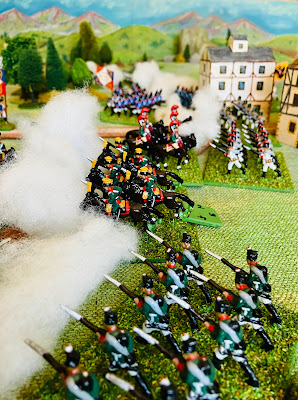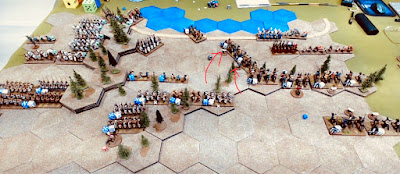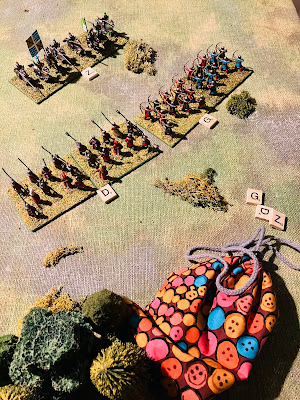This Napoleonic battle report was played using some “home-brew” wargame rules that were inspired by SPI's board game "Napoleon at Waterloo". The rules incorporate hits into the combat results table, rather than retreats from the original board game, and have free movement. You can find a summary of these preliminary rules in my previous post.
In designing the scenario for this game, I have borrowed heavily on ideas from the "2 by 2 Napoleonic" rules. The game is based on an encounter scenario where half of the army's units begin the game in reserve, they will enter the game piecemeal as the game progresses.
 |
| A close up of some Lancers. |
Situation
As the forward units of the Austrian army progress northward, they have come across French units advancing southward in the vicinity of the town of Wiessen. Initial forces have been deployed by both armies, with reserve units expected to arrive during the upcoming battle.
 |
| Scenario Map |
Orders of Battle
At the commencement of the game, the French forces have organised a deployment consisting of 14,000 infantry, 2,000 cavalry, and 20 artillery pieces. These are represented on the tabletop by:
- 6 Line Infantry (2 units are veteran)
- 2 Light Infantry
- 1 Artillery
- 2 Cavalry
The reserve forces for the French consist of 12,000 infantry, 3,000 cavalry, and 20 artillery pieces. Their arrival is scheduled to take place gradually, starting from turn 2 onward.
- 6 Line Infantry (1 unit is veteran)
- 1 Artillery
- 3 Cavalry
At the beginning of the battle, the Austrian deployment includes 12,000 infantry, 2,000 cavalry, and 40 artillery pieces. These forces are represented on the tabletop as follows:
- 6 Line Infantry (1 unit is veteran)
- 2 Artillery
- 2 Cavalry
As reserves, the Austrians hold 12,000 infantry, 3,000 cavalry, and 20 artillery pieces. Their entry into the battle will be gradual, starting from turn 2 onwards.
- 6 Line Infantry (2 units are veteran)
- 1 Artillery
- 3 Cavalry
Deployment
At the game's start, both players have the option to deploy their units within a 9 inches of their respective edges. The French deploy along the northern edge, while the Austrians deploy along the southern edge.
 |
| A view of the initial deployments. Austrians on the left and French on the right. |
Reinforcements
Before the game commences, both players arrange their reserves in the desired order of arrival. Starting from game turn 2, each player checks whether their reserves enter the battlefield. Reserves can appear at specified locations on the tabletop from the rear or flank, determined by 2 dice rolls at the start of a turn.
The French player rolls a die for point B, with a 3+ indicating the arrival of the next reserve unit. For point A, a 4+ is required for the next reserve unit in line to enter.
Similarly, the Austrian player rolls a die for point D, and a 3+ results in the next reserve unit arriving. For point C, a 4+ is needed for the subsequent reserve unit in line to join the battle.
Special Rules
All units have the ability to ford the river, except for artillery, which is restricted to crossing only via the bridge.
Victory Conditions
The victory conditions for both armies is to secure and maintain control of the town of Wiessen.
Battle Report
Reconnaissance reports alerted both generals to the enemy's presence as they advanced to control the river crossing near the town of Wiessen. Both armies swiftly deployed and began their advances, gearing up for the impending battle. The French light infantry successfully occupied the town of Wiessen, while the Austrians secured the heights east of the river, effectively blocking the French left wing from advancing. Initial clashes between the two forces proved inconclusive, prompting the generals to send messages for their reserves to march forward and join the battle!
 |
| Both forces advance and the French light infantry skirmishing ahead are able to occupy the north part of Wiessen town. |
 |
| Some initial reserve units arrive. While the French have been able to secure Wiessen, the Austrians are about to secure the eastern hill. |
 |
| The advancing units soon make contact. |
Game Mid-Point
Both generals eagerly anticipated the arrival of their reserve troops that could be employed in the ongoing battle. Following an initial assault on the heights across the river from Wiessen, the French left flank adopted a more defensive posture. Their reserves were arriving slowly, and those that arrived were directed toward the defence of Wiessen.
The Austrian commander's confidence grew as his reserve units arrived to join the battle. He quickly deployed them to reinforce his assault on Wiessen, which had initially experienced a setback in fortune.
 |
| Artillery are bought up to support attacks as more reserve units arrive for the Austrians. The French reserves are arriving at half the rate which does not bode well and the French General is getting concerned. |
 |
The French have some success forcing Austrian units to retreat, but the reserve units are ready to fill any gaps and continue to mount pressure in and around the town of Wiessen.
|
 |
The lack of French reserves is more acute on their left flank as the Austrians look to counterattack taking advantage of their numerical advantage.
|
 |
The French hold Wiessen but have withdrawn their cavalry to the hill north east of the town waiting for more reserves.
|
 |
| On the French left the French posture is one of defence. At this point all the Austrian reserve units have arrived and only half the French reserves. |
End Game
The dwindling supply of French reserves became a pressing concern. The primary objective for the French commanders now shifted to holding of the town of Wiessen and feeding in any arriving reserve units to its defence. With superior numbers on their right flank, the Austrians successfully outflanked the opposition, turning the retreat into a potential rout. In the centre, Austrian artillery played a crucial role as support for their infantry, reclaiming the town in a brutal and bloody engagement.
Lacking adequate reserves for a counteroffensive, the French general issued a retreat order for his army. The Austrians emerged victorious, securing control of the crucial river crossing.
 |
The Austrians take and occupy Wiessen. A few more French reserves arrive, but they are not in sufficient numbers to counterattack.
|
 |
| The French left has routed and Austrian units move towards the town of Wiessen. The French General retires all his forces. A victory for Austrian forces. |
Summary
Despite securing favorable positions for the arrival of reserves, the French encountered a setback with their slow arrival, enabling the Austrians to seize momentum and initiative. The Austrians, leveraging their numerical superiority, gradually wore down the French defenses in Wiessen. When the French opted to retreat, only half of their reserves had arrived, in contrast to the full deployment of Austrian reserves.
Regarding the rules, the only aspect that raises uncertainty for me is the treatment of light infantry in combat. Currently, the rules have light infantry count as defenders and not attackers. I am considering whether to reverse this and have them count as attackers instead of defenders.
Look and feel of the game
It might appear somewhat of a mismatched to have a unit of ten 30mm Spencer Smith miniatures, representing 2000 troops on the tabletop for infantry and 1000 for cavalry. However, I do try and get the tabletop to look somewhat like some of the battle prints from the period.
 |
A battle print of the period
|
 |
| Action from a previous game. |
Next up is a remote Samurai game with Jon of Palouse Wargaming Journal.




















































